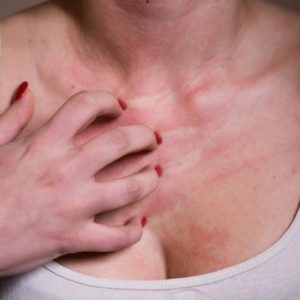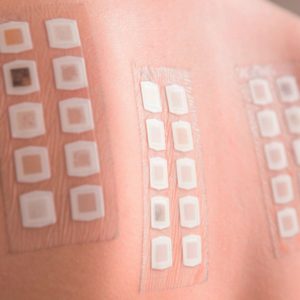Endometriosis and Nickel Allergy: Are There Connections?
Many are familiar with the experience: Shortly after wearing a new piece of jewelry, the skin may redden, itch, burn, and possibly even swell, indicating a nickel allergy. However, what may come as a surprise is the potential link between this allergy and endometriosis, along with the possibility of nickel allergy causing a range of distinct symptoms. Recently, multiple studies have explored this connection, and I have condensed their findings here for your convenience.
Typical Nickel Allergy Symptoms
Nickel allergies typically manifest in two primary ways. Firstly, allergic reactions can occur when the skin directly contacts the metal, resulting in what is known as a contact allergy. These skin symptoms may include:
- Redness of the skin
- Burning or itching sensations
- Swelling
- Crusting or scaling of the skin
- Formation of weeping vesicles or wheals
It is important to note that these reactions usually do not happen immediately upon contact. Initially, your immune system becomes sensitized to the perceived harmful substance. Repeated or prolonged exposure to nickel leads to your body retaining this sensitivity, and symptoms may only surface after one to three days.
What is less commonly known is that nickel can also trigger various internal reactions, not just external ones. This can occur when nickel is ingested through food or inhaled. Potential symptoms can be categorized into two groups. Firstly, gastrointestinal symptoms resembling those often experienced by endometriosis patients may arise. These symptoms include:
- Abdominal pain
- Flatulence
- Diarrhea or constipation
- Nausea and vomiting
- Heartburn
- Mouth ulcers
Furthermore, other bodily systems can be affected. Nickel-sensitive individuals might experience symptoms such as asthma, inflammation of the nasal mucosa, headaches, genital area inflammation, cystitis, joint pain, weakness, and fatigue as part of their allergic reaction to nickel.
Nickel, Diet, and Endometriosis
This intriguing trio has recently been scrutinized in a study [1]. In this research, 83 patients diagnosed with endometriosis initially underwent nickel allergy testing. A questionnaire was employed to determine whether the patients were free from other intolerances (e.g., celiac disease) and whether they experienced at least three gastrointestinal complaints related to endometriosis. As a result, 31 women were selected to participate in the study. They followed a low-nickel diet for three months, after which they reported their endometriosis-related symptoms again. The outcome was striking: the intensity of all 15 gastrointestinal complaints was notably reduced. Moreover, all other symptoms that could be linked to either endometriosis or nickel allergy showed significant improvement.
However, the researchers remain cautious despite the promising results. It is worth noting that the group of women studied was relatively small, and no control group confirmed the findings. Future studies will be essential to substantiate this intriguing discovery further.
Good to Know!
To date, the established link exists between endometriosis and nickel allergy specifically. Other conditions like allergic rhinitis, neurodermatitis, and various contact allergies are not currently associated with endometriosis based on current knowledge and research [3].
Unavoidable Nickel
You may be wondering where nickel is commonly found, and the answer is quite sobering: almost everywhere. Achieving an utterly nickel-free diet is nearly impossible, but a low-nickel diet is undoubtedly feasible. The critical factor is the concentration of nickel, which is entirely possible. As is often the case, it depends on the concentration of specific foods. Nickel enters our food supply through various means. Fresh produce usually naturally contains nickel, as it can be in soil or irrigation water. Using fertilizers and pesticides in fruit and vegetable cultivation can also contribute to higher nickel levels. Processed foods may also have elevated levels, often due to the manufacturing process.
To identify foods and products with exceptionally high nickel content, you can refer to the following table:
| Vegetables | Peas: peas, peanuts, green leafy vegetables (e.g. spinach), chickpeas, kidney beans, garlic, lentils, raw carrots, soy products, tomatoes, and onions. |
| Fruits | Hazelnut, almonds, walnuts. |
| Fish | Herring, salmon, mackerel, shellfish, tuna. |
| Cereals | Buckwheat, oats, millet, corn, rye, whole grain products. |
| Drinks | Beer, coffee, tap water (especially when first turned on in the morning), red wine, tea. |
| Other | Baking powder, gelatin, cocoa, canned food, licorice, flaxseed, marzipan, and supplements containing nickel, chocolate, and sunflower seeds. |
Endometriosis and Nickel: Exploring the Link
Avoiding nickel-containing objects on the skin is relatively straightforward. Many have experienced itchiness and redness from wearing new jewelry with nickel components. But is there a connection between endometriosis and a nickel contact allergy? The answer is yes, as nickel allergy testing is typically conducted on the skin. If a reaction occurs during this test, it indicates an allergy to the metal. Several extensive studies have suggested that a higher-than-average number of individuals with endometriosis exhibit allergic reactions to nickel in this manner [2,3]. On the other hand, internal symptoms, such as irritable bowel syndrome, can be considered an extension of external symptoms. This can happen when nickel exposure is prolonged. Thus, since individuals sensitive to nickel may experience both external and internal signs, with the latter being associated with endometriosis, a link exists between contact allergy and endometriosis.
However, a more intriguing question arises: Can a nickel allergy trigger endometriosis? Researchers have not reached a consensus on this matter. For instance, studies have shown that women with endometriosis tend to have significantly higher nickel levels in their blood than women without the condition [4]. One theory posits that nickel has an estrogen-like structure, which might positively influence the formation of endometriosis lesions. Furthermore, both situations involve autoimmune responses by the body. Nevertheless, these two theories do not entirely account for the connection between nickel allergy and endometriosis, leaving numerous unanswered questions for further investigation.
Brief Note
Nickel allergy is the most prevalent form of contact allergy. Surprisingly, generally harmless nickel ions can provoke a robust immune system response when they come into contact with the skin. Prolonged exposure to this metal can even result in chronic eczema or its spread across the entire body.
Nickel Allergy Detection: What You Need to Know
If you suspect you have a nickel allergy and want a definitive diagnosis, scheduling an appointment with a dermatologist is prudent. During the consultation, your dermatologist will interview you to gather relevant information. Subsequently, a straightforward patch test will be administered. This test involves applying a nickel sample and other common allergens to your back, securing them with adhesive, and leaving them in place for one to two days. If you develop redness and welts in the area after removal, it clearly indicates a nickel allergy.
However, if you know your sensitivity to nickel, you can undertake a self-test. The primary treatment method for nickel allergy is avoidance. Jewelry or clothing fasteners that regularly trigger skin reactions should be avoided. Nevertheless, if you are considering a low-nickel diet, monitoring for any signs of nutrient deficiencies is essential. Suppose certain foods are already restricted from your diet due to endometriosis or other intolerances. In that case, it is advisable to embark on a low-nickel diet under the guidance of a medical professional or nutritionist. You may decide to continue with this dietary approach if you observe improvements in your endometriosis-related symptoms over a few months.
In a Nutshell
Indeed, there is a noteworthy link between nickel allergy and endometriosis in terms of dietary nickel and the more commonly recognized contact allergy. Nevertheless, the specific cause-and-effect relationship remains somewhat unclear and warrants further investigation.
Currently, the primary approach to addressing a nickel allergy is avoidance. This is relatively straightforward for items like jewelry and accessories. However, managing dietary nickel is more challenging since it is in many foods. Nevertheless, a study has demonstrated that a low-nickel diet can ameliorate gastrointestinal discomfort associated with endometriosis. If you experience improved symptoms, that is a positive outcome, and you can continue with this diet. However, if you are eliminating other food groups, it is essential to monitor your nutrient intake to ensure a balanced diet.
References
- Borghini, R. et al. 2020. „Irritable Bowel Syndrome-Like Disorders in Endometriosis: Prevalence of Nickel Sensitivity and Effects of a Low-Nickel Diet. An Open-Label Pilot Study.“ Nutrients 12 (2): 341.
- Yuk, J. et al. 2015. „Nickel Allergy Is a Risk Factor for Endometriosis: An 11-Year Population-Based Nested Case-Control Study.“ PLOS ONE. https://journals.plos.org/plosone/article?id=10.1371/journal.pone.0139388 (Zugriff am 14.03.2022).
- Yuk, J. et al. „High rate of nickel allergy in women with endometriosis: A 3-year population-based study.“ The Journal of Obstetrics and Gynecological Research 41 (8): 1255-1259.
- Silva, N. et al. 2013. „Elevated levels of whole blood nickel in a group of Sri Lankan women with endometriosis: a case control study.“ BMC Research Notes 6: 13.
Do you also have a nickel allergy, and have you experimented with a low-nickel diet?
You are welcome to share your experiences in the comments.
- Endometriosis and Nickel Allergy: Are There Connections? - 5. October 2023
- Psychoneuroimmunology – Immune System in Permanent Stress - 10. September 2023
- Unlocking the Mystery of Vulvodynia: Understanding Pubic Pain - 9. September 2023


